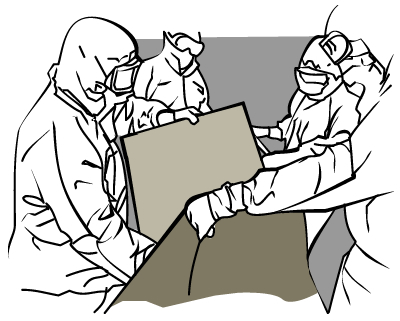What is asbestos and asbestos sheeting?
Asbestos is a naturally occurring mineral that has been used extensively for thousands of years. Valued for its ability to absorb thermal and chemical energy, by the late 1800’s asbestos was being mined and manufactured into various household goods and building materials - particularly as insulation.

What are the potential health risks of asbestos and asbestos sheeting?
Asbestos has been banned from use in Australia since 2003 due to its association with a number of serious lung diseases. Duty of care from government and the asbestos mining industry was shown to be shamefully absent when it emerged that asbestos was suspected of being a serious health danger for at least 50 years before it was formally banned from use.
Asbestos is now associated with a number of life threatening conditions including:
● Lung cancer
● Asbestosis (progressive and irreversible scarring of lung tissue that impairs breathing)
● Mesothelioma (cancer of the linings around the lungs and abdomen)
● Non-cancerous diseases that affect the linings around the lungs and abdomen
Where is asbestos and asbestos sheeting most commonly found?
Asbestos and asbestos sheeting can be found in various places inside and outside the home. In regards to walls and ceilings, it may often be found in vermiculite or popcorn ceilings, as well as asbestos fibre sheeting. Asbestos fibre sheeting was commonly used to build the walls of ‘fibro’ shacks or holiday homes, as well as houses in Australia’s tropical regions.
- If you're not sure whether or not a part of your home is asbestos, call a qualified asbestos remover to come and check it out. Asbestos can be extremely dangerous, and it's not worth taking risks with!
How to handle asbestos and asbestos sheeting
The current thinking on materials containing asbestos can be summarised as ‘let sleeping dogs lie’. If the material containing asbestos is sound and undamaged, it is unlikely to be causing you any harm. Removing it may actually be more dangerous than leaving it be. Inspect the material regularly to ensure it is still in good condition, and if it is showing signs of deterioration, act without delay.
Materials containing asbestos need to be handled with extreme caution. Careless handling has the potential to seriously affect your health and that of other members of your household. Your neighbours and any animals that happen to be in the area are also at risk.
By law, any area over 10 square metres of asbestos sheeting needs to be removed by a licensed asbestos removal contractor - although there are risks involved with removing smaller quantities too. In almost all cases, it's best to hire a contractor with expertise in asbestos removal to ensure that it's carefully taken out of your home and properly disposed of. You can also seek disposal advice relevant to your council area from the Environmental Protection Agency (EPA).





